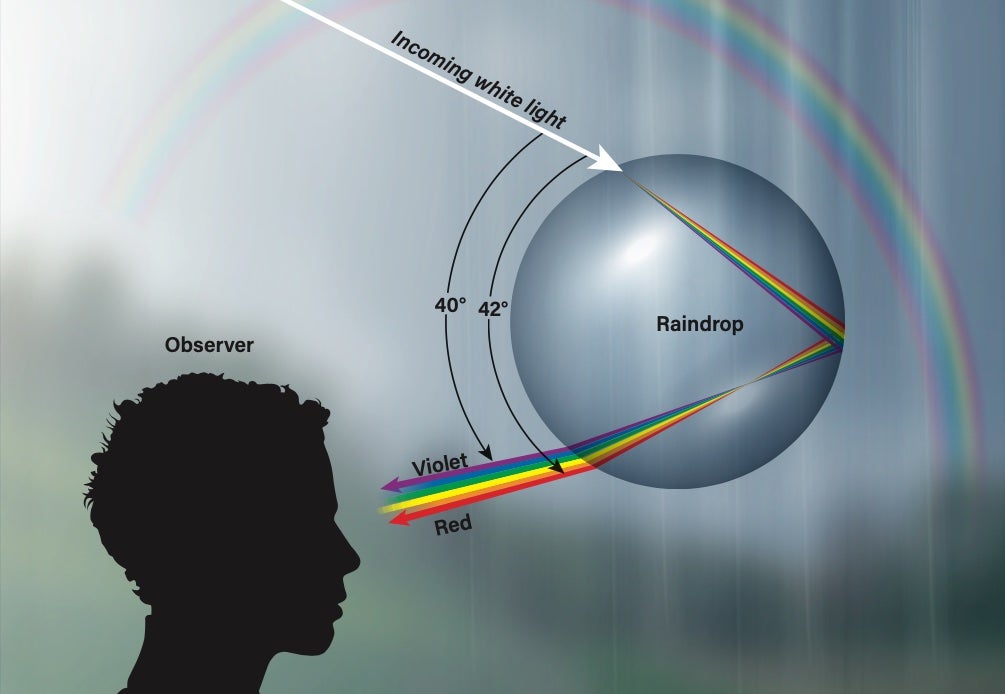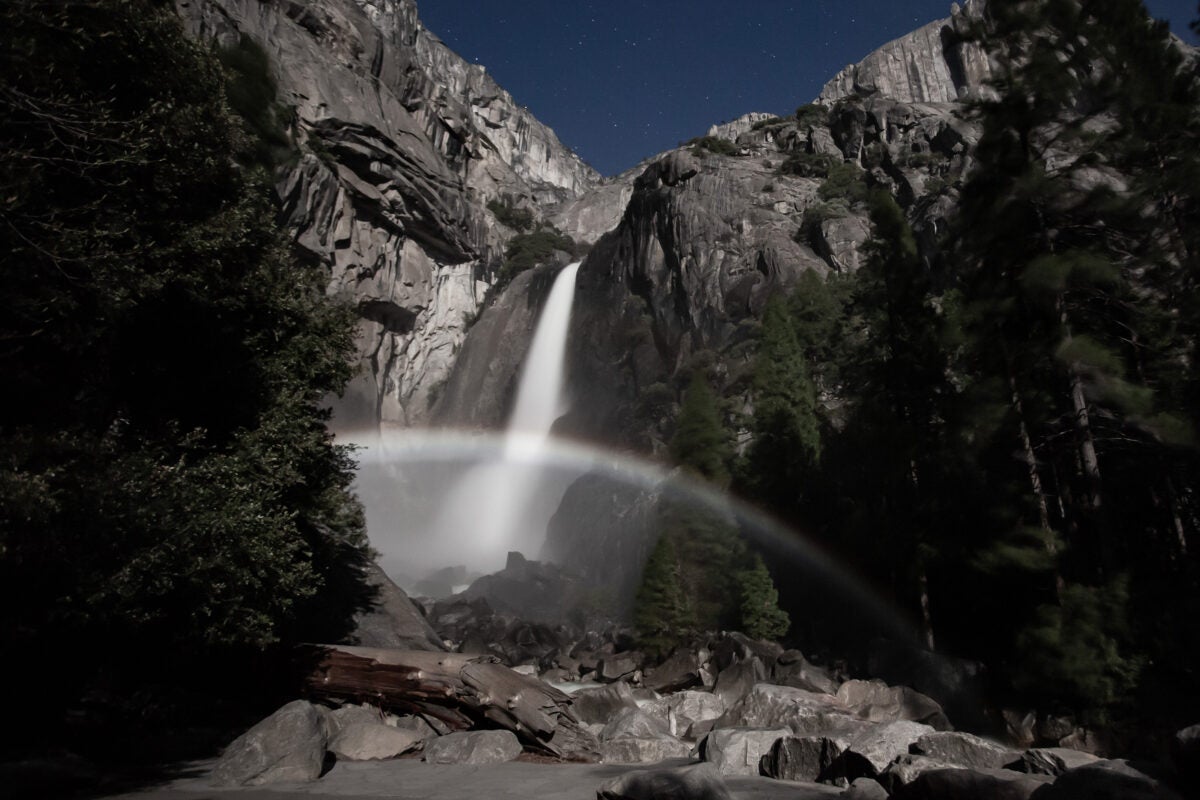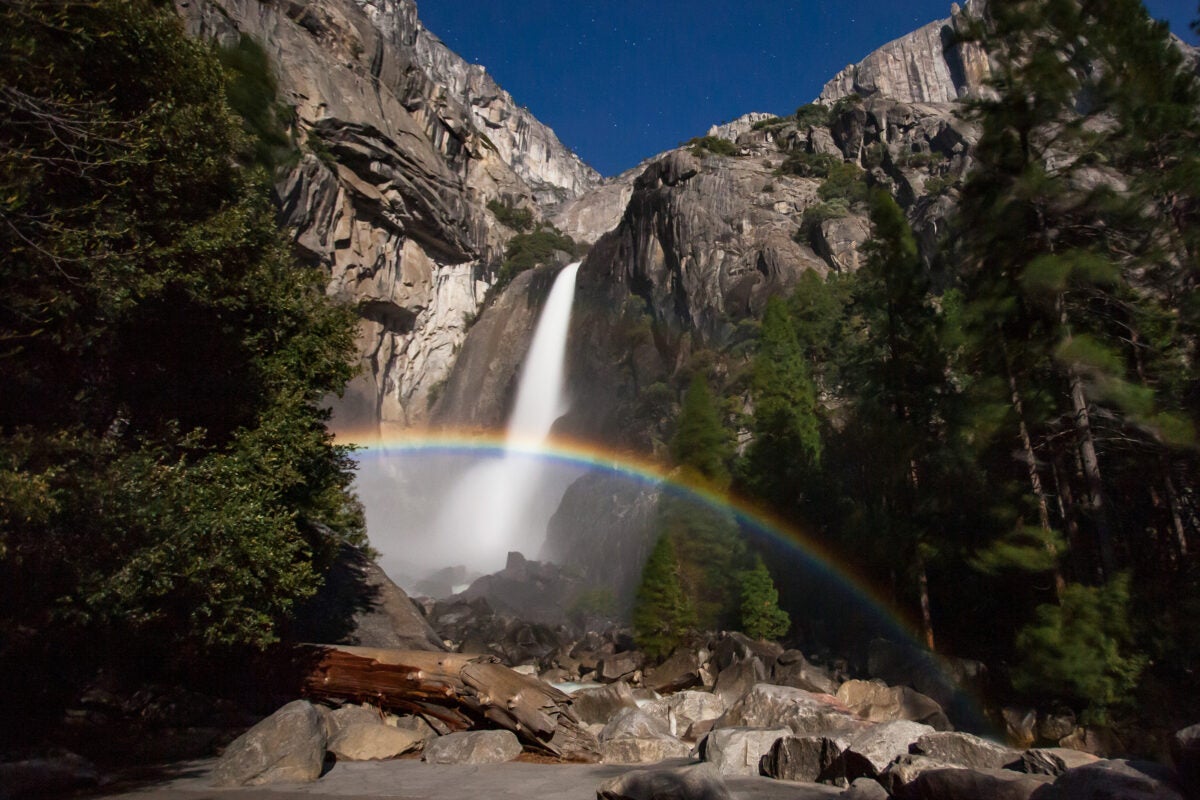
Rainbows don’t actually exist. You can’t find the end of a rainbow (or its attendant pot of gold). It’s not possible to walk across a rainbow as the Norse gods did on the Bifrost, the bridge for fallen warriors to reach Valhalla, or to travel over one like Dorothy to Oz.
Rather, rainbows and other similar phenomena are truly in the eye of the beholder — or, we might say, in the mind of the beholder. Seeing a rainbow is the result of a cosmic interplay between solar radiation, optical physics, billions of water droplets, and the ability of the human brain to separate white light into the visible spectrum.
It’s easy to understand the awe and wonder — not to mention myth, religious devotion, and poetry — inspired by the appearance of a beautiful rainbow after a storm has cleared. Ancient cultures had their own stories about rainbows, such as the Greek belief in Iris, goddess and personification of the rainbow.
For most of human history, rainbows were considered tangible objects. But we now know these beautiful atmospheric apparitions are exactly that: visions caused by nature and physics. As the French astronomer Camille Flammarion said, the effects of light “produce a thousand optical phenomena, always curious, often fantastic, but all capable of explanation.”
We can see clearly now
Learning the truth of how sunlight interacts with the atmosphere to allow us to see rainbows took hundreds of years and a good deal of investigation.
The great Arab scientist Hasan Ibn al-Haytham, known in the West as Alhazen, per-formed groundbreaking work in optics at the end of the 10th and beginning of the 11th century. He did experiments on the dispersion of light and suggested that rainbows formed when sunlight struck the concave surfaces of clouds. At about the same time, the Persian mathematician Abu Sad al-Ala’ Ibn Sahl was describing the laws of refraction.
Building on Alhazen’s work, in the early 14th century the German Dominican friar Theodoric of Freiberg began experimenting with water flasks to simulate drops. He realized that light was bent — refracted — and then reflected and refracted again within the water drops, while Islamic mathematician Al-Farisi, also known as Kamal al-din, was the first to determine the colors of the rainbow come from white light. In 1621, Willebrord Snel van Royen (also known as Willebrord Snell), a Dutch astronomer and mathematician, rediscovered Ibn Sahl’s law of refraction, now known as Snell’s law. René Descartes, a contemporary of Snell but working independent of him, also studied refraction in water and provided an accurate mathematical explanation for the rainbow.
Then, in 1666, Isaac Newton had a lot of time on his hands. Cambridge University had shut down due to an outbreak of the plague. While at home, he performed one of the most famous experiments in physics. In a darkened room, he passed sunlight through a prism to study what he would call the spectrum. Newton demonstrated that white light is composed of the same colors as the rainbow, spreading from red to violet. His discovery was a culmination of the work of those who had investigated these phenomena before him.

Ingredients to make a rainbow
Four conditions are needed to see a rainbow: The Sun must be only a certain height above the horizon, it must be shining through the clouds, raindrops must be present in the atmosphere, and you need to look directly opposite the Sun. If all of these criteria are met, you will see one of nature’s most beautiful sights.
Rainbows can never be seen when the Sun is high in the sky. This is because of the angles at which light is refracted as it enters a raindrop, reflects off its internal surface, and is refracted again as it exits the drop. The end result is that light emerges from the drop most concentrated near the maximum angle of about 42°, its colors slightly dispersed, to form the primary rainbow. This rainbow appears to surround the antisolar point — the point opposite the Sun — at an angle of 42°.
Accordingly, the Sun needs to be 42° or less above the horizon for the rainbow to be visible. If it is higher, you will also need to be higher — on a mountain or in an airplane — to see the light at the angle at which it emerges from the raindrops.
Most commonly, a rainbow is seen as a single arching bow with colors ranging from red at the outer boundary to violet at the inside. We see red at the top of the rainbow because it is bent at the shallowest angle. Blue and violet are bent the most, and appear at the bottom of the bow. Usually, the primary bow is described as seven colors, represented by the acronym ROYGBIV: red, orange, yellow, green, blue, indigo, violet. But depending on how intense the rainbow appears, you might see more gradations between each color.
Sometimes, a secondary rainbow can be seen above the primary bow. Because it is caused by an additional reflection within the raindrops, less light emerges, resulting in the secondary being only one-tenth as bright as the primary rainbow. Also, because of the number of reflections, the colors in the secondary bow are reversed. The sky between the two bows appears noticeably darker than the sky above the secondary and below the primary bow. This phenomenon is known as Alexander’s Dark Band, named after Alexander of Aphrodisias, who described this strange phenomenon in the 3rd century.
If conditions are just right, a third, or tertiary, rainbow may be seen above the secondary. It is even fainter than the secondary and is quite rare. In L’Atmosphere, Flammarion describes several other extremely unusual types of rainbows. He tells of Edmund Halley’s observation of “three arches, one of which … reflected upon a river. This arch first intersected the exterior arch so as to divide it into three equal parts. When the Sun sunk toward the horizon, the points of meeting were drawn close together. There soon was seen but one single arch, and as the colors were in inverse order, pure white was formed by the superposition of the two series.”


Personalized rainbows
I was once asked to speak at a friend’s Unitarian church while the minister was out. He told me I could talk on any topic I liked. The title of my “sermon” was “Everyone Sees Their Own Rainbow.”
When you see a rainbow, your eyes are at the apex of a cone formed by the light rays that are being reflected by the raindrops that happen to be at a 42° angle from the antisolar point — from your perspective. (This cone is sliced off by the horizon, which means the average observer is only seeing half of the full circle of a rainbow; the full circle is sometimes visible from an airplane when the horizon is far below.)
If you are driving when you see a rainbow, it will seem to follow you. This is because your cone of vision is what is doing the moving. And if you and a friend are standing next to each other, you are both seeing your own personal rainbows. Admittedly, if asked, you will describe them the same way; your cone of vision, however, means it’s all yours. I have always thought of this as a wonderful metaphor for individuality.
What about someone who is severely colorblind? How do they see this atmospheric phenomenon? In the most extreme cases of colorblindness, a person may only see 1 percent of the range of colors visible to someone with unaffected vision. To most colorblind individuals, rainbows may appear to have fewer hues or look more muted: Red may appear more brown and green might be an olive tone.
Rainbows in the night
If rainbows are caused by the interaction of sunlight and raindrops, how do we explain reports by Aristotle, Amerigo Vespucci, Benjamin Franklin, and others of nocturnal rainbows?
These individuals were not hallucinating. Lunar rainbows, or moonbows, are created by reflected sunlight from the Moon. Moonbows are quite rare because even more conditions must come together to create them.
Moonbows can only be seen when the Moon is Full or very near Full, which happens 12 or 13 times a year. The Full Moon is about 400,000 times fainter than the Sun, so if you are in a light-polluted area, your chances of seeing a moonbow are almost zero. Just as with a daytime rainbow, the Full Moon must be no more than 42° above the horizon. That means you need to look for a moonbow shortly after the Full Moon rises or not long before it sets. And of course, water drops must be present in the atmosphere. If all these conditions are in place, you might see a faint gossamer moonbow opposite the Full Moon.
Our color perception decreases at low light levels. The color-receptor cones in our eyes need a fair amount of intensity to start distinguishing colors. Even though all the rainbow colors are present in a moonbow, it usually appears pale white to the naked eye. Photographs, however, can capture the colors. And don’t confuse a lunar halo, which is a circle around the Moon formed by light refracted by ice crystals, for a moonbow. The moonbow is always opposite the Full Moon.
A continuing allure
Rainbows have long been the subject of myths and stories, of art and music. And despite our modern scientific understanding, they remain part of our culture.
Even if the rainbow is only in our mind’s eye, it is as real as the Sun’s light and Earth’s water, providing us with a wonderful cosmic connection.









